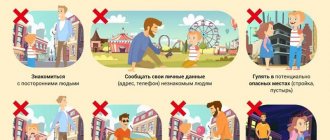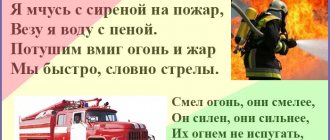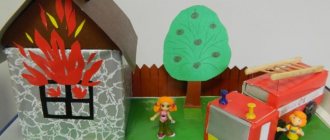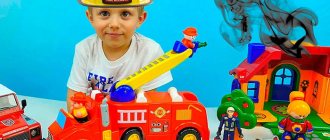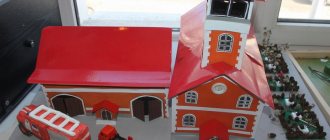Game "Fire".
At the signal (fire siren), the players run from the starting line to the chairs on which the equipment is laid out: helmet, gloves, belt, etc. They need to prepare for departure - put on the equipment. The one who gets dressed the fastest wins.
Game "Scouts".
On command, players must overcome an obstacle course, get to the chair with the doll, and “take it out of the fire.” The one who reaches the finish line first wins. The game can be complicated by asking the “scouts” to move blindfolded (heavy smoke). In this case, the obstacle course should be short and not very difficult.
Game "Firefighting".
At a given signal, players draw water from a large basin with a small bucket and pass it to each other, lining up in a chain. The latter pours water into an empty container. The team that fills it out the fastest wins.
Game "After the Fire".
Players sit on chairs, pick up reels, each of which has a cord (fire hose) attached to one end. The winner is the one who winds the cord onto the reel faster.
Questions and answers on fire safety
Goal : to consolidate knowledge about the correct actions in the event of a fire.
Progress of the game:
Questions and answers are presented in the form of pictures (questions on one tray, answers on the other). For each situation it is necessary to choose the right answer.
Situations:
- There was a fire.
- There is a lot of smoke in the room.
- Your clothes are on fire.
- The TV started smoking.
- The old grass is burning.
- I smelled gas.
- It is difficult to breathe from the acrid smoke.
Answers:
- Call "01".
- Crawl your way to the exit.
- Get on the floor and roll.
- Turn it off, cover with a blanket.
- Cover it with soil and fill it with water.
- Open the window, call “04”.
- Breathe through the wet rag.
Author's didactic game "Fire Safety Lessons"
Everyone has probably heard the Russian proverb more than once: “Spark the carcass before the fire, avert trouble before the blow.”
Behind it one can discern the experience of many generations of our ancestors. The conversation about pranks and children’s careless handling of fire is not new. Some people may say: “Is it worth returning to this topic? Need I repeat that matches in the hands of a child are a dangerous, sometimes deadly toy? It’s not worth it, the topic is already hackneyed.” But statistics show the opposite. The number of fires caused by children playing with fire is not decreasing. Children die in fires and material assets are destroyed. The cause of casualties among children is the children’s lack of skills in handling fire carefully, insufficient control over their behavior, and in some cases, the inability of adults to properly organize children’s leisure time. You can teach a child to correctly answer questions on safe behavior and how to act correctly in a certain situation, but a small child does not have the ability to recognize the type of dangerous situation and immediately act in it. It is impossible to work with children on every possible situation they may find themselves in. Therefore, it is very important to form in a child the concepts of “danger - safety”, allowing him to independently determine the status of the situation in different areas of life and act in it.
This game will help in a fun and exciting way to develop the basics of fire safety in preschoolers, including fire-safe behavior.
Tasks
1. Introduce children to the rules of behavior in case of fire. To consolidate knowledge about the causes of fires, safety rules and available fire extinguishing means.
2. To develop the ability to realistically assess possible danger. Help children remember fire safety rules. Develop the ability to call a firefighter by telephone.
3. Foster a sense of caution and self-preservation.
4. Cultivate feelings of gratitude towards people who help in difficult situations.
5. Instill in children responsibility for playing pranks with fire.
Description
The game is a cube, on each side of which there are various, interesting tasks.
Crossword
Goal: to teach children to solve riddles, develop logical thinking and imaginative imagination.
Contents of the game: an adult asks riddles for children and writes down the answers. For each correct answer, the child receives a chip, and the child who gets the most chips wins.
Proverbs and sayings
Goal: to develop a conscious attitude towards oneself as an active subject of fire safety, to form habits of compliance with them. To develop the ability to understand the content of folk wisdom and apply it in practice.
Contents of the game: the teacher, together with the children, looks at pictures on fire safety. Informs children that people have invented many proverbs and sayings. Next, the teacher reads proverbs and sayings to the children. Children learn one of them. When repeating the game, a new proverb or saying is learned.
Didactic game “What is useful in case of fire”
Goal: to teach children to find objects that may be useful to a firefighter when putting out a fire. Cultivate respect for people who help in difficult situations.
Contents of the game: children are asked to look at the objects in the pictures and name them. The player is asked to choose from the proposed items what the firefighter needs during firefighting. Explain your choice.
Labyrinth "House", "Circle"
Goal: To develop logical thinking, fine motor skills of the hands, and navigate in space.
Game content: the player (firefighter) needs to go through the maze, choosing the right path and getting to the source of the fire. If the path has been followed correctly, the fire is considered extinguished.
Fire safety signs
Goal: consolidate knowledge about fire symbols.
Contents of the game: the teacher shows a picture of one of the fire safety signs and tells what it means. Then he asks the children to remember where they saw such a sign (on the territory of the kindergarten, outside the territory of the kindergarten).
Fire safety game Prohibited - allowed
Objectives: consolidation of knowledge about basic fire safety requirements; increasing personal responsibility for one’s actions; formation of discipline, sense of duty.
Material:
Each child has one signal card - “traffic light”. One side of the green traffic light is “permissive”, the other side is red – “prohibiting”.
Progress of the game:
The teacher names the basic fire safety requirements in random order, and the children show the corresponding “traffic light” colors.
Methodological material for the game:
Prohibited:
- Throw burning matches and cigarette butts indoors.
- Throw away burning ash near buildings.
- Leave the doors of stoves and fireplaces open.
- Use homemade devices and fuses.
- Connect a large number of current consumers (more than three) to one outlet.
- Use faulty equipment and devices.
- Use damaged sockets.
- Wrap electric lamps and lamps with paper, cloth and other flammable materials.
- Use electric irons, stoves, kettles without stands made of fireproof materials.
- Leave electrical heating devices, radios, etc. plugged in unattended.
- Use electrical cords and drives with damaged insulation.
- Set up workshops and warehouses in apartments of residential buildings where explosive materials are used and stored.
- Leave burning stoves unattended, and also entrust small children with supervision of them.
Necessary:
- Protect yourself, property, residential building, cottage, garage, car, as well as state property from fire.
- In the event of a fire, call the fire department by phone “01”, provide the address where the fire occurred and give your last name.
- Evacuate children, sick, elderly, and disabled people from fires.
- Sound the alarm.
- Meet the firefighters and inform them about the fire.
- Post a sign in the educational institution indicating the emergency telephone number of the fire department: “01”.
- Learn to use a fire extinguisher;
- Know the evacuation plan in case of fire.
- Do not open doors in the room where the fire has occurred.
- Scream and call adults for help.
- Cover your nose and mouth with a wet bandage (handkerchief, scarf) to protect from smoke.
- Throw a piece of thick cloth moistened with water, a wet blanket, a raincoat, or a coat over yourself when you are in a fire zone.
- Move by crawling or crouching along the wall if the room is heavily smoky.
- Throw a blanket over the victim if his clothes catch fire, and press it tightly against the person’s body to stop the access of air.
- Extinguish clothes by taking them off or pressing yourself to the ground, floor, or wall.
- Open windows and doors for ventilation in smoky rooms where there is no fire.
- Remove the victim who has been taken outside from his clothes or unfasten the collar and loosen the clasp.
- Call an ambulance for the victim by calling “03” and send him to the hospital.
Progress of the game:
The teacher lays out on the table, or puts in a beautifully decorated box, cards with questions on the topic of rules of behavior during a fire . The child who answers the question correctly The one who has the most chips at the end of the game wins.
Question options:
- Name the possible cause of the fire ;
- how to call the fire department correctly ;
- what to do if during a fire there is no way to call the fire brigade , and the routes out of the house are cut off by the fire ;
— is it possible to extinguish a fire without first calling the fire brigade ;
- what to do if there is a smell of gas in the house;
— is it possible to hide in a closet or under a table during a fire ;
— Is it possible to set poplar fluff on fire?
— Is it possible to create a draft during a fire by opening all windows and doors at the same time;
— is it possible to use the elevator during a fire in the house ;
first during : money, documents or yourself;
— how to properly leave a smoky room;
— Is it possible to play with matches and lighters and why.
Didactic game : “Name the causes of the fire ”
Goal: to develop knowledge about the causes of fire . Develop attention, memory, speech. Cultivate responsibility.
Progress of the game:
The child is shown a picture depicting various uses of fire (both good and bad)
.Children are given
cards with images of fire and objects related to fire (matches, firewood, gas stove, kerosene lamp, etc.)
Children must place
the cards on the picture - in the right place .
Didactic game : “Say a word”
Goal: to consolidate knowledge about fire . Develop vocabulary, attention, memory.
Work clothes
For this lesson you will need paper cut-out images of a boy and a girl, different types of work wardrobe, as well as corresponding professional tools.
The presenter explains that the paper dolls are going to work, and you need to help them choose a suitable wardrobe. Then he places a picture of a tool next to each doll, from which the players must guess what item of clothing is needed. Children dress dolls and name their profession. And so for every work clothing.
Progress of the game:
From the plot pictures (children collecting autumn leaves, children hanging burning candles on the Christmas tree, a boy playing with matches , children watering flowers, etc.), the child must choose those situations that could cause a fire and justify his answer, for that gets the chip. The one who has the most chips at the end of the game wins.
Didactic game : “Choose the right one”
Goal: to develop children’s knowledge about the items needed when extinguishing a fire , the rules for their use . Reinforce knowledge about objects that can cause a fire . Develop speech, memory, logical thinking. Foster a sense of responsibility.
Role-playing game “Fire in the Forest” (senior group)
V: Here we are. The first stop is “Radioroom”. Come in, sit back, put on your headphones, turn on your computers.
Promote the creative use of ideas about PPD in the game. Develop creative imagination, the ability to jointly unfold the yoke.
Children are given cards, each depicting four objects, one of which is redundant (is dangerous). The one that the teacher points to (the magic arrow) explains what is unnecessary and why.

